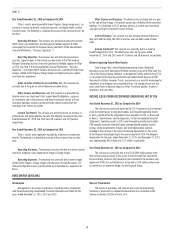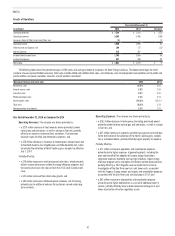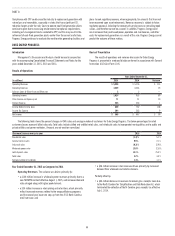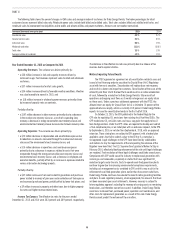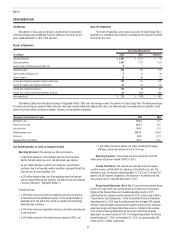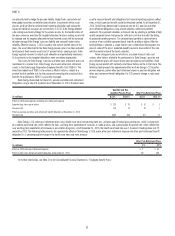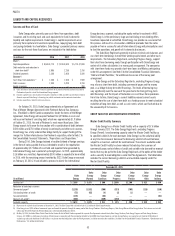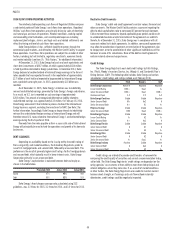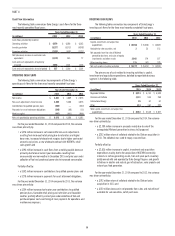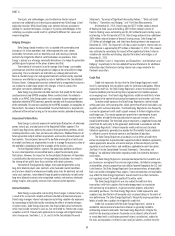Duke Energy 2015 Annual Report Download - page 70
Download and view the complete annual report
Please find page 70 of the 2015 Duke Energy annual report below. You can navigate through the pages in the report by either clicking on the pages listed below, or by using the keyword search tool below to find specific information within the annual report.
50
PART II
Regulatory Accounting
Regulated Utilities, Duke Energy’s regulated operations, meets the
criteria for application of regulatory accounting treatment for substantially all
of its operations. As a result, Duke Energy records assets and liabilities that
would not be recorded for nonregulated entities. Regulatory assets generally
represent incurred costs that have been deferred because such costs are
probable of future recovery in customer rates. Regulatory liabilities generally
represent obligations to make refunds or reduce rates to customers for previous
collections or for costs that have yet to be incurred.
Management continually assesses whether recorded regulatory assets
are probable of future recovery by considering factors such as applicable
regulatory environment changes, historical regulatory treatment for similar costs
in Duke Energy’s jurisdictions, litigation of rate orders, recent rate orders to
other regulated entities, levels of actual return on equity compared to approved
rates of return on equity, and the status of any pending or potential deregulation
legislation. If future recovery of costs ceases to be probable, asset write-offs
would be recognized in operating income. Additionally, regulatory agencies
can provide flexibility in the manner and timing of the depreciation of property,
plant and equipment, recognition of asset retirement costs, and amortization of
regulatory assets, or may disallow recovery of all or a portion of certain assets.
For further information on regulatory assets and liabilities, see Note 4 to the
Consolidated Financial Statements, “Regulatory Matters.”
As required by regulated operations accounting rules, significant judgment
can be required to determine if an otherwise recognizable incurred cost, such as
closure costs for ash impoundments, qualifies to be deferred for future recovery
as a regulatory asset. Significant judgment can also be required to determine if
revenues previously recognized are for entity specific costs that are no longer
expected to be incurred and are therefore a regulatory liability. See Note 4 to the
Consolidated Financial Statements, “Regulatory Matters,” for a more in-depth
discussion of Regulatory Assets and Liabilities.
Regulatory accounting rules also require recognition of a disallowance
(also called “impairment”) loss if it becomes probable that part of the cost of a
plant under construction (or a recently completed plant or an abandoned plant)
will be disallowed for ratemaking purposes and a reasonable estimate of the
amount of the disallowance can be made. For example, if a cost cap is set for
a plant still under construction, the amount of the disallowance is a result of a
judgment as to the ultimate cost of the plant. Other disallowances can require
judgments on allowed future rate recovery. See Note 4 to the Consolidated
Financial Statements, “Regulatory Matters,” for a discussion of disallowances
recorded related to the Edwardsport IGCC Plant and the retired Crystal River
Unit 3 Nuclear Plant.
When it becomes probable that regulated generation, transmission or
distribution assets will be abandoned, the cost of the asset is removed from
plant in service. The value that may be retained as a regulatory asset on the
balance sheet for the abandoned property is dependent upon amounts that
may be recovered through regulated rates, including any return. As such, an
impairment charge, if any, could be offset by the establishment of a regulatory
asset if rate recovery is probable. The impairment for a disallowance of costs for
regulated plants under construction, recently completed or abandoned is based
on discounted cash flows.
For further information, see Note 4 to the Consolidated Financial
Statements, “Regulatory Matters.”
Goodwill Impairment Assessments
Duke Energy allocates goodwill to reporting units, which are either the
Business Segments listed in Note 3 or one level below based on how the
Business Segment is managed. Duke Energy is required to test goodwill for
impairment at least annually and more frequently if it is more likely than not
that the fair value is less than the carrying value. Duke Energy performs its
annual impairment test as of August 31.
Application of the goodwill impairment test requires management
judgment, including determining the fair value of the reporting unit, which
management estimates using a weighted combination of the income approach,
which estimates fair value based on discounted cash flows, and the market
approach, which estimates fair value based on market comparables within the
utility and energy industries. Significant assumptions used in these fair value
analyses include discount and growth rates, future rates of return expected
to result from ongoing rate regulation, utility sector market performance and
transactions, projected operating and capital cash flows for Duke Energy’s
business and the fair value of debt.
Estimated future cash flows under the income approach are based
to a large extent on Duke Energy’s internal business plan, and adjusted as
appropriate for Duke Energy’s views of market participant assumptions. Duke
Energy’s internal business plan reflects management’s assumptions related
to customer usage and attrition based on internal data and economic data
obtained from third-party sources, projected commodity pricing data and
potential changes in environmental regulations. The business plan assumes the
occurrence of certain events in the future, such as the outcome of future rate
filings, future approved rates of returns on equity, anticipated earnings/returns
related to significant future capital investments, continued recovery of cost of
service, the renewal of certain contracts and the future of renewable tax credits.
Management also makes assumptions regarding operation, maintenance
and general and administrative costs based on the expected outcome of the
aforementioned events. In estimating cash flows, Duke Energy incorporates
expected growth rates, regulatory and economic stability, the ability to renew
contracts and other factors, into its revenue and expense forecasts.
One of the most significant assumptions that Duke Energy utilizes in
determining the fair value of its reporting units under the income approach
is the discount rate applied to the estimated future cash flows. Management
determines the appropriate discount rate for each of its reporting units based on
the weighted average cost of capital (WACC) for each individual reporting unit.
The WACC takes into account both the after-tax cost of debt and cost of equity.
A major component of the cost of equity is the current risk-free rate on 20-year
U.S. Treasury bonds. In the 2015 impairment tests, Duke Energy considered
implied WACCs for certain peer companies in determining the appropriate WACC
rates to use in its analysis. As each reporting unit has a different risk profile
based on the nature of its operations, including factors such as regulation, the
WACC for each reporting unit may differ. Accordingly, the WACCs were adjusted,
as appropriate, to account for company specific risk premiums. The discount
rates used for calculating the fair values as of August 31, 2015, for each of
Duke Energy’s domestic reporting units ranged from 5.9 percent to 7.1 percent.
For Duke Energy’s international operations, a country-specific risk
adder based on the average risk premium for each separate country in which
International Energy operates was added to the base discount rate to reflect the
differing risk profiles. This resulted in a discount rate for the August 31, 2015,
goodwill impairment test for the international operations of 10.5 percent.
The underlying assumptions and estimates are made as of a point in time.
Subsequent changes, particularly changes in the discount rates, authorized
regulated rates of return or growth rates inherent in management’s estimates of
future cash flows, could result in future impairment charges.


